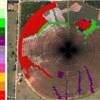Abstract
Most fields are not uniform because of natural variations in soil type or topography. When water is applied uniformly to a field, some areas of the field may be overwatered while other areas may remain too dry. Variable-rate irrigation technology gives farmers an automated method to vary rates of irrigation water based on the individual management zones within a field and avoid irrigating roadways, waterways, wetlands, and other non-farmed areas within a pivot. This 3-page fact sheet was written by Calvin Perry, Clyde Fraisse, and Daniel Dourte, and published by the UF Department of Agricultural and Biological Engineering, July 2012.
References
Almas, L.K., S.H. Amossono, T. Marek, and W.A. Colette. 2003. "Economic Feasibility of Precision Irrigation in the Northern Texas High Plains." Presentation at the Southern Agricultural Economics Association Annual Meeting, Mobile, AL, February 1-5, 2003.
Hedley, C., I. Yule , M. Tuohy, and I. Vogeler. 2009. Key Performance Indicators for Variable Rate Irrigation Implementation on Variable Soils. Paper Number: 096372. ASABE Meeting Presentation. Accessed July 2012. http://elibrary.asabe.org/azdez.asp?JID=5&AID=27439&CID=reno2009&T=2.
Sadler, E.J., R.G. Evans, K.C. Stone, and C.R. Camp. 2005. "Opportunities for Conservation with Precision Irrigation." J. Soil Water Conserv. 60 (6): 371-9.

